A container of volume 4V0 made of a perfectly non− conducting material is divided into two equal parts by a fixed rigid wall whose lower half is non− conducting and upper half is purely conducting. The right side of the wall is divided into equal parts ( initially 0 by means of a massless non− conducting piston free to move as shown . Section A contains 2mol of a gas while the section B and C contain 1mol each of the same gas (γ=15.) at pressure P0 . The heater in left part is switched on till the final pressure in section C becomes 125/27P0. Calculate
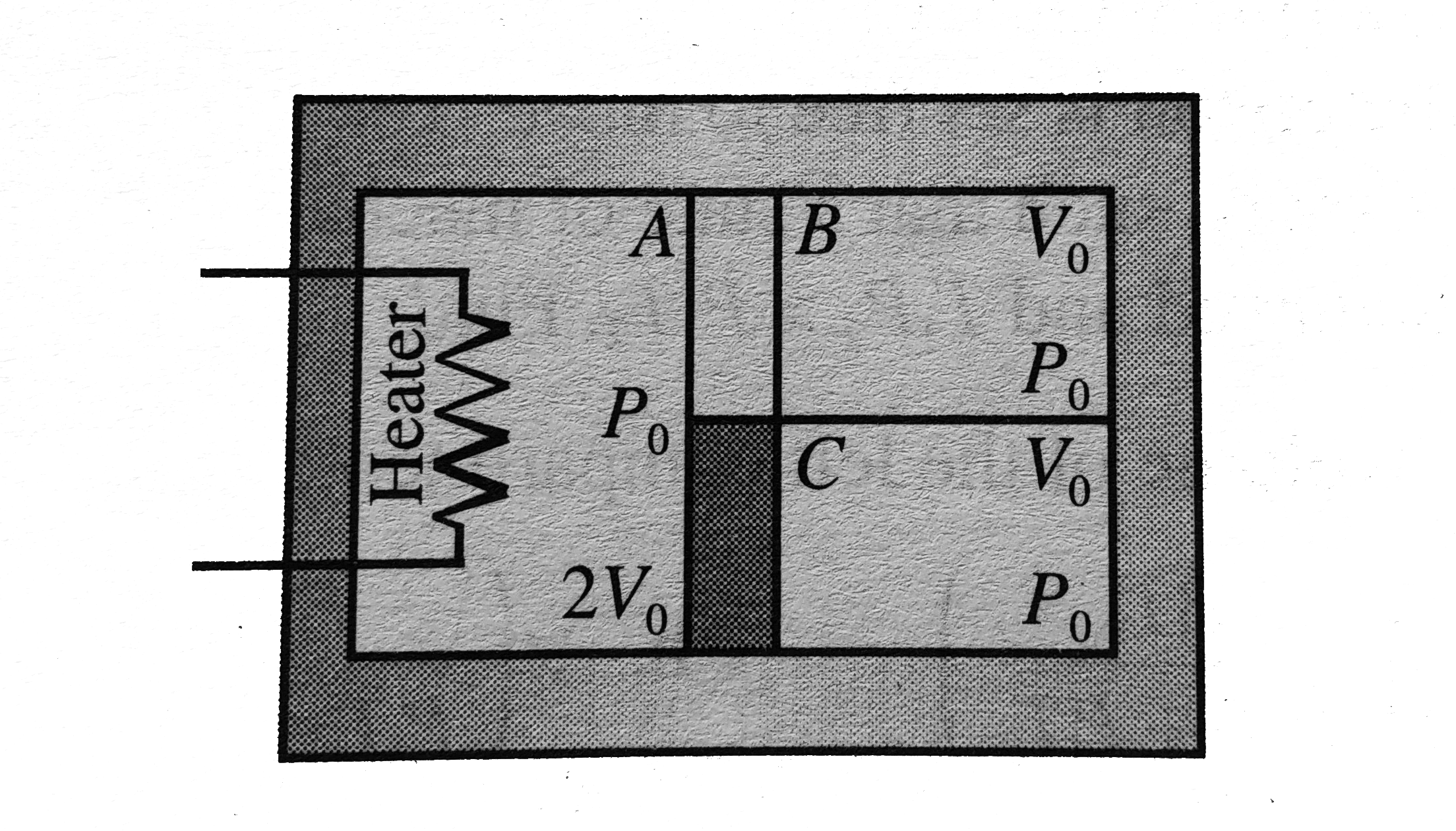
The heat supplied by the heater.
3689P0V0
1135P0V0
3169P0V0
4058P0V0
The correct Answer is:A
For 'C',P0Vγ0=12527P0VγC
VC=V0(925)
VB=2V0−9V025=(50−9)25V0
VB=4125V0
T0A=T0B=P0V0R
TC=12527P0×925V0R=5P0V03R
TB=12527P0×4125V0R=20527P0V03R=TA
Q=nACV(TA−T0)+nBCVΔTB+nCCVΔTC
Q=2.2R(20527−1)P0V0R+1.2R(20527−1)P0V0R+1.2R[53P0V0R−P0V0R]
=2P0V0[178×227+17827+23]=3689P0V0
Topper's Solved these Questions
- KINETIC THEORY OF GASES AND FIRST LAW OF THERMODYNAMICSBook:CENGAGE PHYSICSChapter:KINETIC THEORY OF GASES AND FIRST LAW OF THERMODYNAMICSExercise:Interger
Explore 11 Videos
- KINETIC THEORY OF GASES AND FIRST LAW OF THERMODYNAMICSBook:CENGAGE PHYSICSChapter:KINETIC THEORY OF GASES AND FIRST LAW OF THERMODYNAMICSExercise:Assertion-Reasoning
Explore 6 Videos
- KINETIC THEORY OF GASESBook:CENGAGE PHYSICSChapter:KINETIC THEORY OF GASESExercise:Compression
Explore 2 Videos
- LINEAR AND ANGULAR SIMPLE HARMONIC MOTIONBook:CENGAGE PHYSICSChapter:LINEAR AND ANGULAR SIMPLE HARMONIC MOTIONExercise:Multiple Correct Answer Type
Explore 9 Videos
Similar Questions
8g of oxygen, 14 g of nitrogen and 22 g carbon dioxide are mixed in an encloser of volume 10 litre and temperature 27∘C. Calculate the pressure exerted by the mixture , R=8.3Jmole−1K−1, Molecular weight of oxygen , nitrogen and carbon 32 , 28 and 44 respectively.
View SolutionStatement I: A quasi -static process is so called bacause it is a sudden and large change of the system.
Statement II: An adiabatic process is not quasi- static because it is a sudden and large change of the system.
View SolutionOne mole of an ideal monatomic gas undergoes a linear process from A to B , in which is pressure P and its volume V change as shown in figure .
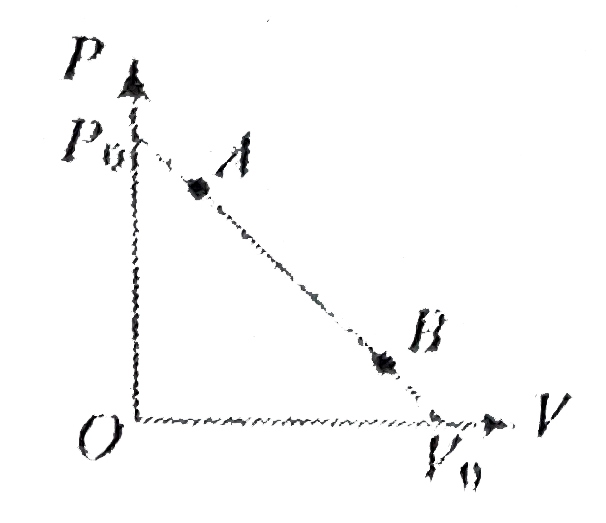
The absolute temperature T versus volume V for the given process is
View SolutionThe springs shown in the figure are all upstretched in the beginning when a man starts pulling the block. The man exerts a constant force F on the block.
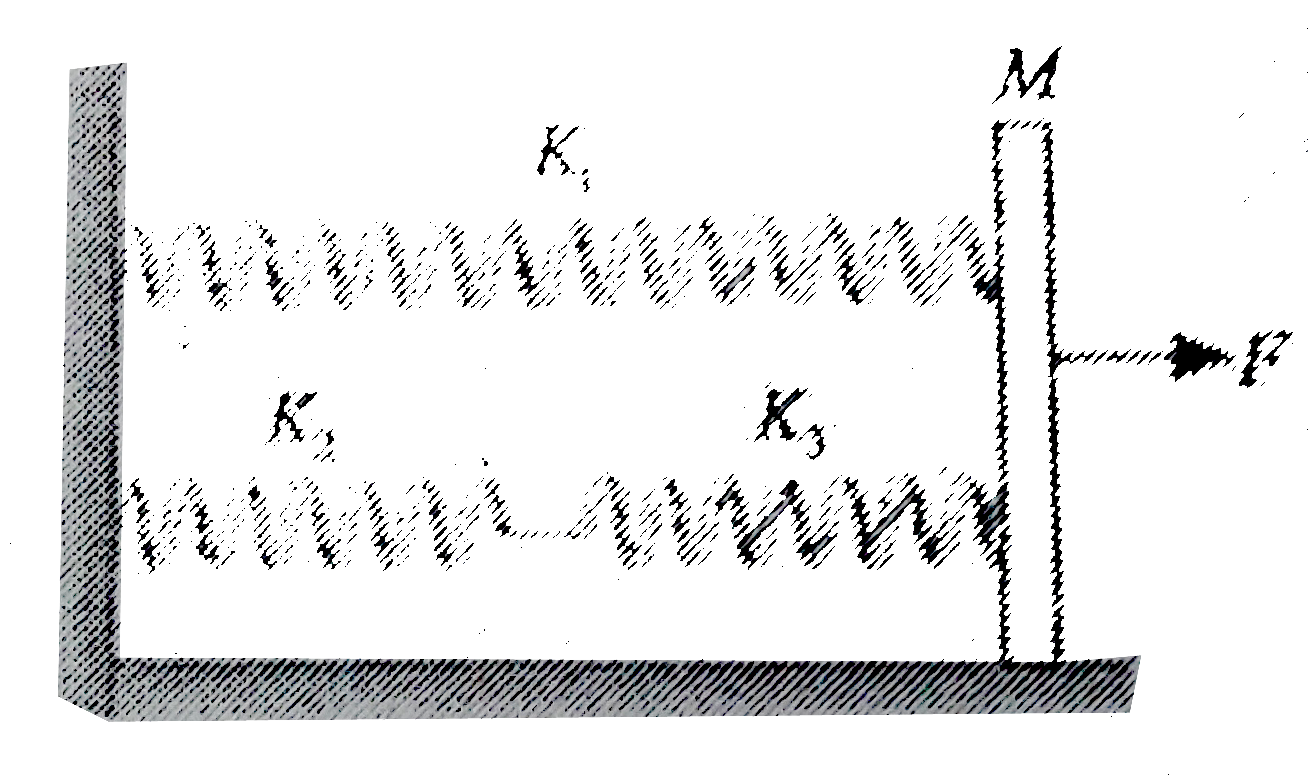
View SolutionA container of volume 4V_(0) made of a perfectly non - conducting material is divided into two equal parts by a fixed rigid wall whose lower half is non - conducting and upper half is purely conducting. The right side of the wall is divided into equal parts ( initially 0 by means of a massless non - conducting piston free to move as shown . Section A constains 2 mol of a gas while the section B and C contain 1 mol each of the same gas ( gamma = 15. ) at pressure P_(0) . The heater in left part is switched on till the final pressure in section C becomes 125//27 P_(0) . Calculate Final temperature in part A .
View SolutionA container of volume 4V0 made of a perfectly non− conducting material is divided into two equal parts by a fixed rigid wall whose lower half is non− conducting and upper half is purely conducting. The right side of the wall is divided into equal parts ( initially 0 by means of a massless non− conducting piston free to move as shown . SectionA constains 2mol of a gas while the section B and C contain 1mol each of the same gas (γ=15.) at pressure P0 . The heater in left part is switched on till the final pressure in section C becomes 125/27P0. Calculate
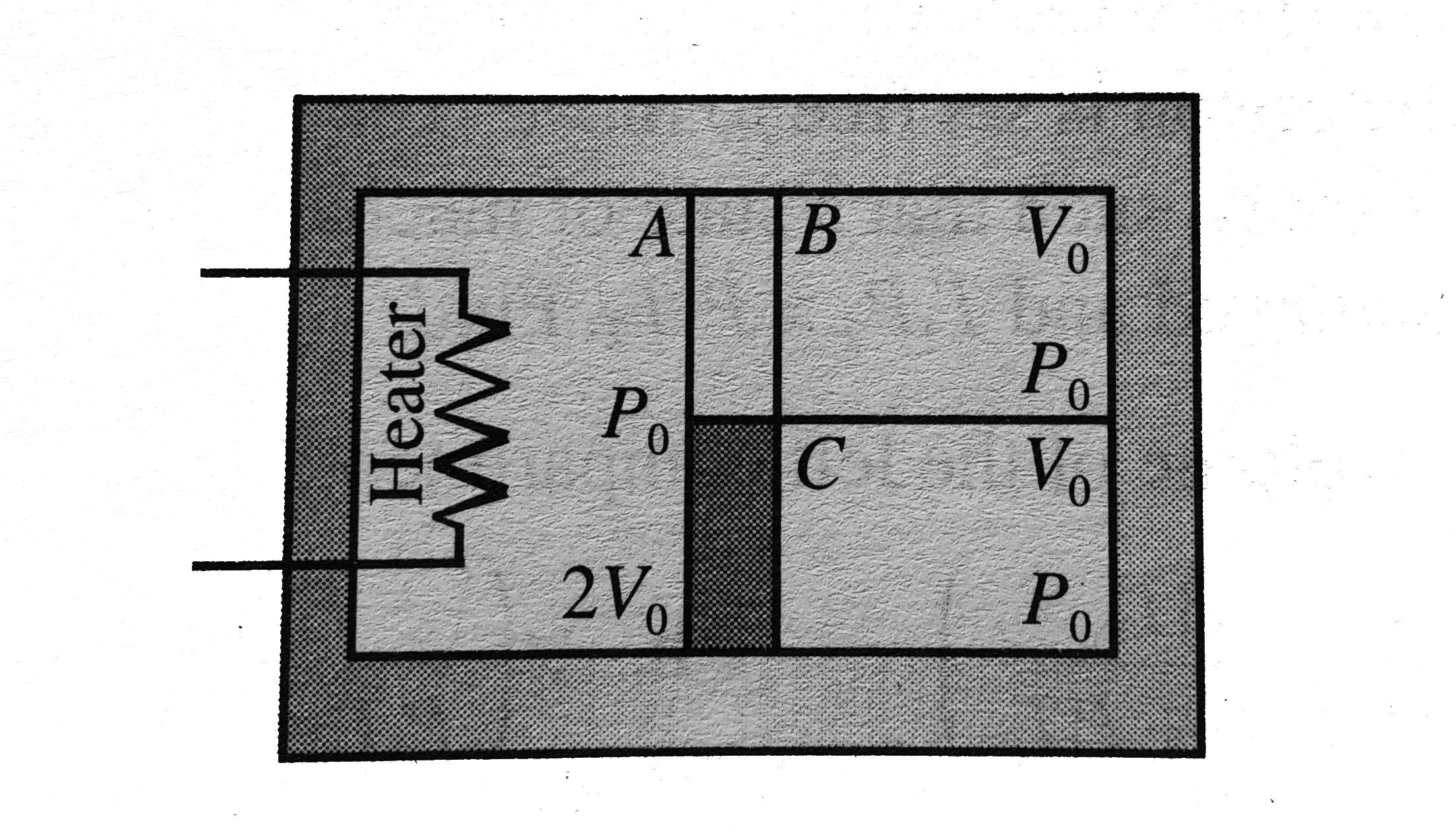
Final temperature in part C.
View SolutionComprehension-2
A mono atomic ideal gas is filled in a non conducting container. The gas can be compressed by a movable non conducting piston. The gas is compressed slowly to 12.5% of its initial volume.
The percentage increases in the temperature of the gas is
View SolutionA cylinder contains equal volumes of Ar and H2, separated by a freely movable piston B. Piston A can also move without friction. Volume of each gas in equilibrium isV0. All walls of the container including piston A are non conducting.
(i) Piston A is pushed down slowly till the volume occupied by argon becomes V04 . Find the volume of H2. Assume that piston B is also non conducting.
(ii) Now assume that piston B is conducting and assume that each gas has n moles. The external agent performs work W0 in slowly pushing down the piston A. Find rise in temperature of each gas.
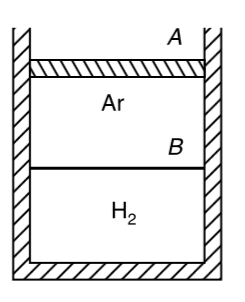
View SolutionA cylindrical adiabatic container of total volume 2V0 divided into two equal parts by a conducting piston which is free to move as shown in figure. Each part containing identical gas at pressure P0. Initially temperature of left and right part is 4T0andT0 respectively. An external force is applied on the piston of area 'A' to keep the piston at rest. The value of external force required when thermal equilibrium is reached is.
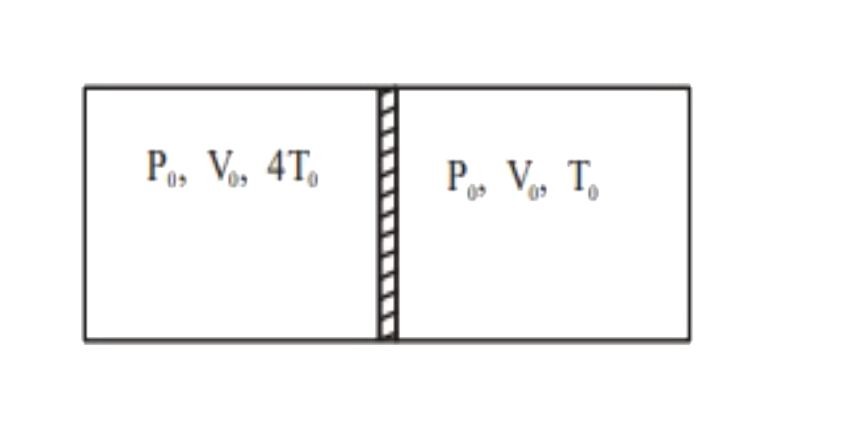
View SolutionA non - conducting piston of mass m and are S0 divides a non - conducting, closed cylinder as shown in the figure. A piston having mass m is connected with the top wall of the cylinder by a spring of force constant k. The top part is evacuated and the bottom part is evacuated and the bottom part contains an ideal gas at a pressure P0 in the equilibrium position. Adiabatic exponent γ and in equilibrium length of each part is l. (neglect friction). Find the angular frequency for small oscillation.
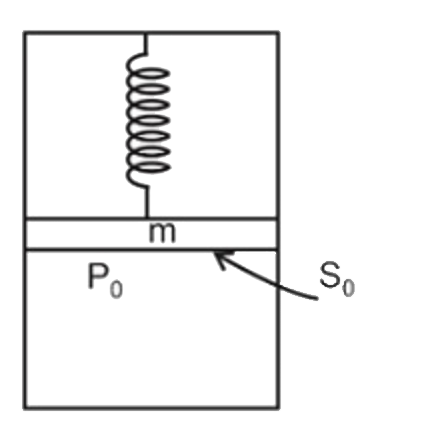
View SolutionA cylindrical container having non-conducting walls is partitioned in two equal parts such that the volume of the each parts is eqaul to V0 A movable non-conducting piston is kept between the two parts. Gas on left is slowly heated so that the gas on right is compressed upto volume V0/8. Find pressure and temperature on both sides if initial pressure and temperature, were P0 and T0 respectively. Also find heat given by the heater to the gas (number of moles in each parts is n)
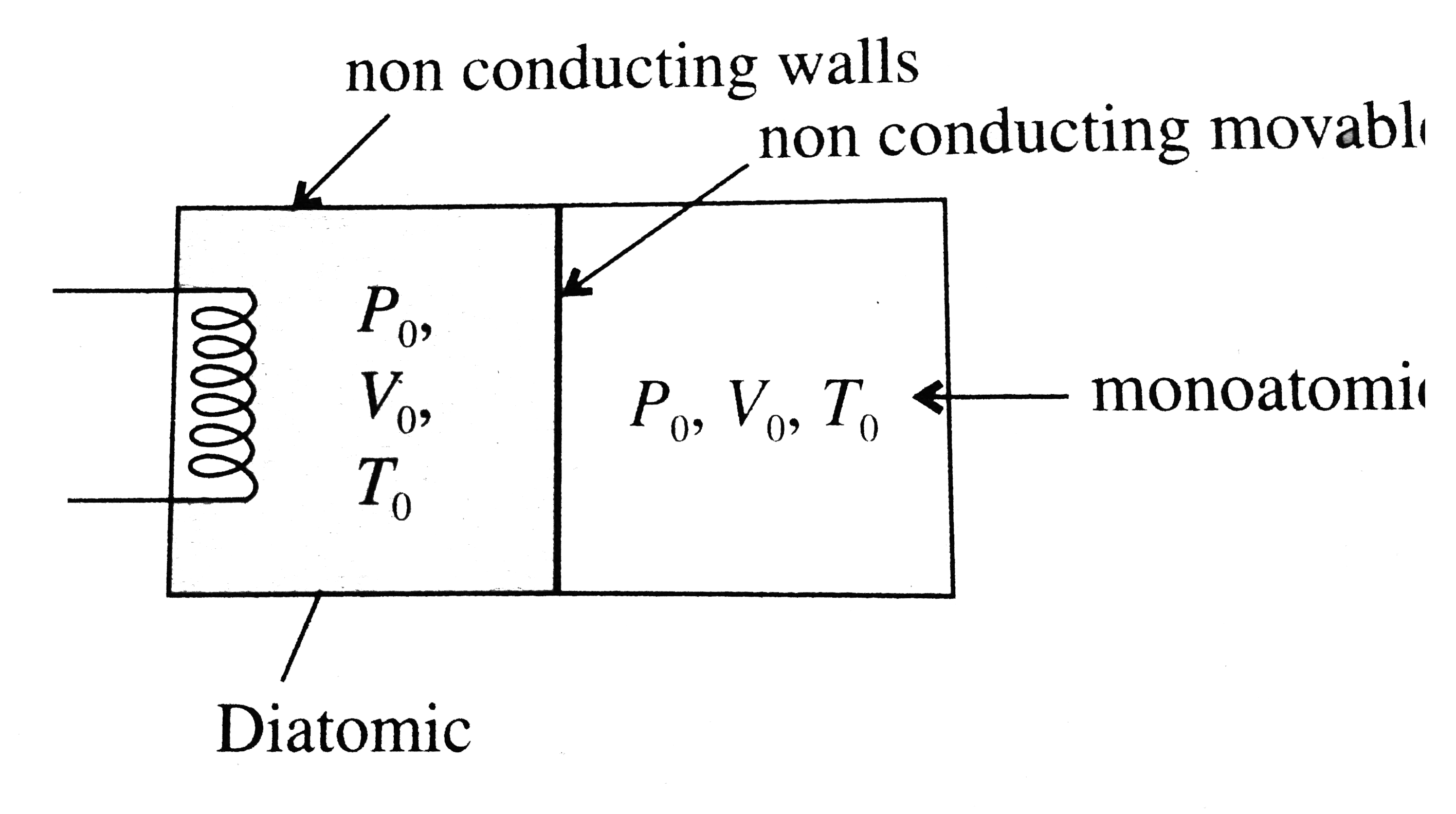
View SolutionA non-conducting cylinder having volume 2V0 is partitioned by a fixed non conducting wall in two equal part. Partition is attached with a valve. Right side of the partition is a vacuum and left part is filled with a gas having pressure and temperature P0 and T0 respectively. If valve is opened find the final pressure and temperature of the two parts.
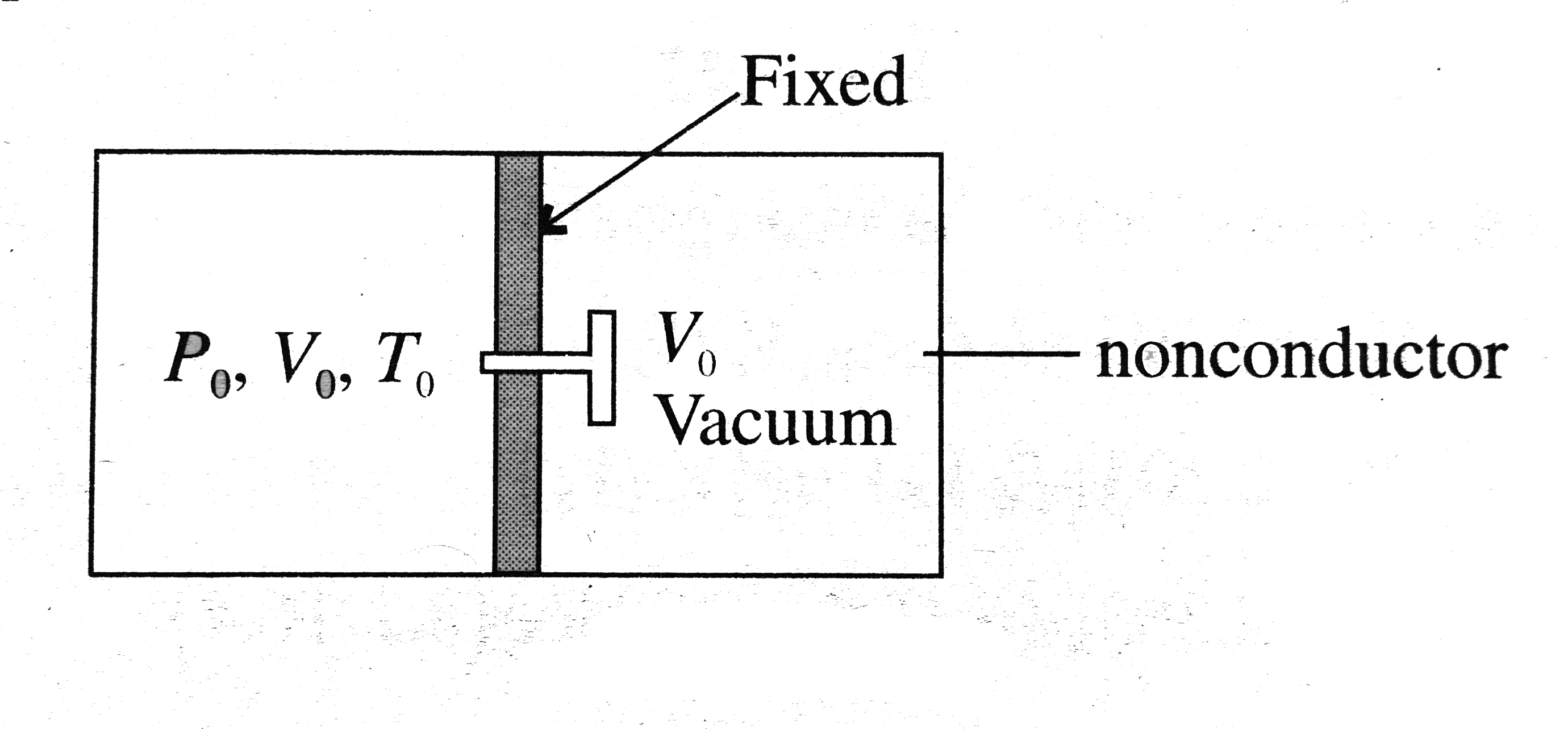
View SolutionA container of volume 4V0 made of a perfectly non− conducting material is divided into two equal parts by a fixed rigid wall whose lower half is non− conducting and upper half is purely conducting. The right side of the wall is divided into equal parts ( initially 0 by means of a massless non− conducting piston free to move as shown . SectionA constains 2mol of a gas while the section B and C contain 1mol each of the same gas (γ=15.) at pressure P0 . The heater in left part is switched on till the final pressure in section C becomes 125/27P0. Calculate

Final temperature in part C.
View SolutionA container of volume 4V_(0) made of a perfectly non - conducting material is divided into two equal parts by a fixed rigid wall whose lower half is non - conducting and upper half is purely conducting. The right side of the wall is divided into equal parts ( initially 0 by means of a massless non - conducting piston free to move as shown . Section A constains 2 mol of a gas while the section B and C contain 1 mol each of the same gas ( gamma = 15. ) at pressure P_(0) . The heater in left part is switched on till the final pressure in section C becomes 125//27 P_(0) . Calculate The heat supplied by the heater.
View SolutionA cylindrical container having non-conducting walls is partitioned in two equal parts such that the volume of the each parts is eqaul to V_(0) A movable non-conducting piston is kept between the two parts. Gas on left is slowly heated so that the gas on right is compressed upto volume V_(0)//8 . Find pressure and temperature on both sides if initial pressure and temperature, were P_(0) and T_(0) respectively. Also find heat given by the heater to the gas (number of moles in each parts is n)
View Solution

